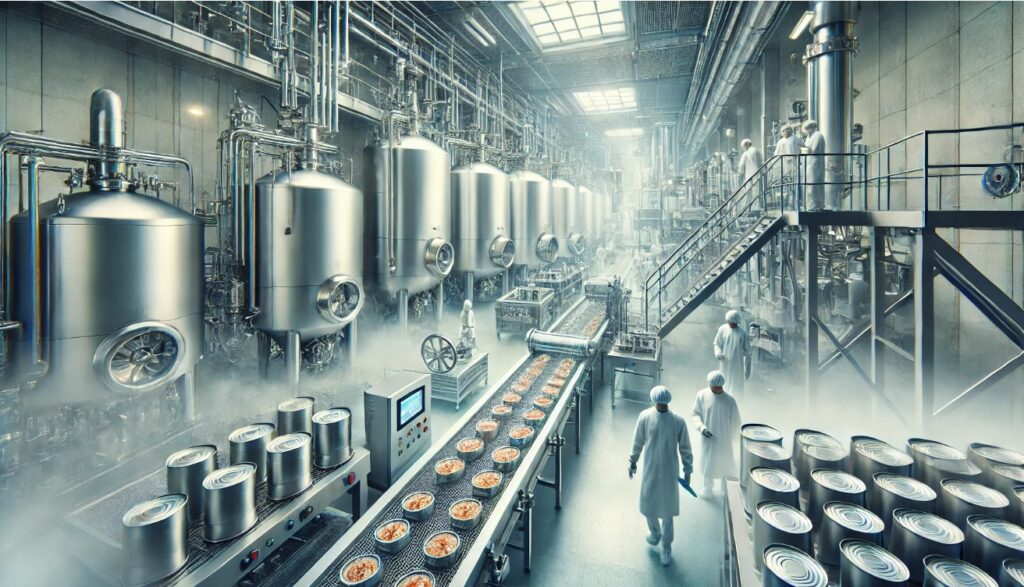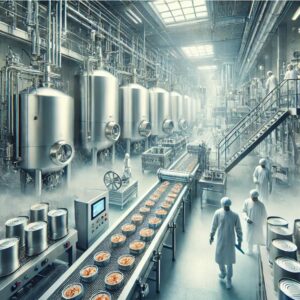Thermal Processing

Trainer:
Dr Sagar Gokhale
Category:
Total Lectures:
10
Duration:
15 hours
Language:
English
Rating:
Price:
₹2999
Thermal Processing
What is Thermal Processing?
Thermal processing is a food preservation technique that involves applying heat to destroy harmful microorganisms, inactivate enzymes, and extend shelf life while maintaining the nutritional and sensory quality of food. It is widely used in industries like dairy, beverages, canned foods, bakery, and ready-to-eat meals.
Types of Thermal Processing
1. Pasteurization
-
Temperature: 60–85°C (140–185°F) for a few seconds to minutes.
-
Purpose: Destroys pathogenic bacteria while retaining most nutrients and flavor.
-
Common Applications:
-
Milk & dairy (prevents spoilage and diseases like tuberculosis).
-
Juices (extends shelf life without altering taste significantly).
-
Eggs & beer (prevents contamination).
-
Types of Pasteurization:
-
Low-Temperature Long-Time (LTLT): 63°C for 30 minutes (used in small-scale dairy).
-
High-Temperature Short-Time (HTST): 72°C for 15 seconds (used in large-scale milk processing).
-
Ultra-High Temperature (UHT): 135°C for 2-5 seconds (used for long-life milk and juices).
2. Sterilization
-
Temperature: 110–135°C (230–275°F) for several minutes.
-
Purpose: Kills all microorganisms, including spores, for long shelf life.
-
Common Applications:
-
Canned foods (vegetables, soups, meats).
-
UHT milk (requires no refrigeration for months).
-
Baby food (ensures complete safety for infants).
-
Methods of Sterilization:
-
Retort Processing: Uses high-pressure steam to sterilize canned foods.
-
Aseptic Processing: Sterilizes food and packaging separately before sealing.
3. Blanching
-
Temperature: 70–100°C (158–212°F) for a few seconds to minutes.
-
Purpose:
-
Inactivates enzymes to preserve color, texture, and flavor.
-
Reduces microbial load before further processing.
-
-
Common Applications:
-
Vegetables before freezing (e.g., peas, carrots).
-
Nuts before peeling (e.g., almonds).
-
4. Baking & Roasting
-
Temperature: 120–260°C (248–500°F) for minutes to hours.
-
Purpose:
-
Kills microbes.
-
Develops texture, flavor, and aroma.
-
-
Common Applications:
-
Bread, cookies, cakes (baking for structure and texture).
-
Coffee beans, nuts, cocoa (roasting for flavor development).
-
5. Extrusion Cooking
-
Temperature: Up to 200°C (392°F) under high pressure.
-
Purpose:
-
Cooks, sterilizes, and shapes food while improving texture.
-
Reduces anti-nutritional factors in grains.
-
-
Common Applications:
-
Breakfast cereals (cornflakes, puffed rice).
-
Snack foods (chips, extruded pasta).
-
Pet food (improves digestibility).
-
6. Microwave & Infrared Processing
-
Temperature: Varies based on time and power level.
-
Purpose:
-
Rapid heating for sterilization and cooking.
-
Reduces cooking and drying time.
-
-
Common Applications:
-
Microwave meals (quick heating with minimal nutrient loss).
-
Drying herbs & spices (preserves essential oils).
-
Factors Affecting Thermal Processing Efficiency
1️⃣ Food Composition – Fat, protein, and water levels impact heat transfer.
2️⃣ Container Type – Metal cans conduct heat faster than plastic or glass.
3️⃣ pH Level – High-acid foods (pH < 4.6) require less heat.
4️⃣ Time & Temperature Combination – Must be optimized to balance safety and quality.
Benefits of Thermal Processing
✅ Kills pathogens & increases food safety.
✅ Extends shelf life by preventing spoilage.
✅ Preserves texture, color, and nutritional value (when optimized).
✅ Reduces food waste by preventing early deterioration.
Limitations:
1. High heat may degrade some vitamins (e.g., vitamin C).
2. Overprocessing can alter flavor and texture.
3. Requires proper packaging to maintain quality.
Applications in the Food Industry
-
Dairy Industry: Pasteurization of milk, yogurt, and cheese.
-
Beverage Industry: UHT processing of juices and plant-based milk.
-
Canning Industry: Sterilization of soups, vegetables, and seafood.
-
Frozen Food Industry: Blanching of vegetables before freezing.
-
Bakery Industry: Baking bread, cookies, and crackers.
Final Thoughts
Thermal processing is a crucial technology for ensuring food safety and quality. The choice of method depends on the food type, shelf life requirements, and processing goals. New innovations, like microwave sterilization and high-pressure processing (HPP), are being explored to improve efficiency while maintaining nutrition.
Dr Sagar Gokhale is the Co-founder and owner of Ojman Foodbio which is involved in the manufacture of herbal tea, dry mixes, fruit syrups, etc. It has business in both B-to-B as well as the retail sector. He has worked with Pune-based company, “Kwanza Animal Health” for development of dog “treats”. He has also worked with Mumbai based company, “Hi-Media” on statistical optimization of fermentation media to maximize cell production. He was visiting lecturer for Advances in Food Technology for M.Tech. Foods and Food Engineering for B.Tech. Foods at Department of Food Engg. & Tech., Institute of Chemical and Visiting lecturer in Chemical and Biochemical Engineering: Integrated M.Tech.-Ph.D. the course at the Department of Technology, University of Pune. He is completed PhD and MTech from ICT Mumbai.
Course Content
Only logged in customers who have purchased this product may leave a review.
Other course you might interested in
-
Career & Education
CFTRI – Bundle Of Courses – Agriculture, Maths And Chemistry
Rated 0 out of 5₹2000Original price was: ₹2000.₹1600Current price is: ₹1600.





Reviews
There are no reviews yet.